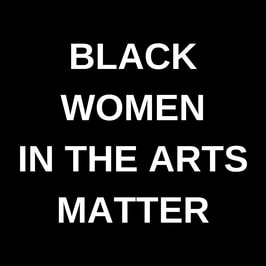ABOUT THE PROJECT: As an arts organization dedicated to recognizing the contributions of women in the arts, NCWCA will be highlighting 27 Black Women in the Arts throughout 2020 in honor of Breonna Taylor. Breonna would have turned 27 years old this year had she not been murdered in her own home by the police on March 13th. #JusticeForBre
27 Black Women in the Arts:
#9: Toyin Ojih Odutola (1985 – Present)
By Angela Han
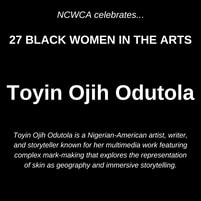
Toyin Ojih Odutola is a Nigerian-American artist, writer, and storyteller known for her multimedia work featuring complex mark-making that explores the representation of skin as geography and immersive storytelling.
*** What can we learn from her life and work? ***
1) Using materials such as ballpoint pen, pencil, charcoal, pastel, and chalk, Ojih Odutola merges drawing and narrative to develop detailed portraits that push the boundaries of traditional portraiture and expand the dimensions of visual storytelling.
2) Through her comprehensive research, imagination, and distinctive mark-making, she creates speculative worlds that weave together themes of identity, authenticity, and odyssey. She focuses on the topography of skin as a medium through which to communicate the inner landscapes of her characters, inviting viewers to traverse stories that undulate between fiction and reality.
3) Her notable series include “Satellite” (2021-2022), “A Counterveiling Theory” (2019-2020), “To Wander Determined” (2017), “Untold Stories” (2014), and “My Country Has No Name” (2012-2013).
4) Ojih Odutola has exhibited at the San Francisco Museum of Modern Art (SFMOMA), Museum of African Diaspora (MoAD), Whitney Museum of American Art, Hirshorn Museum and Sculpture Garden, and Smithsonian’s National Museum of African Art, among others. She earned her MFA in 2012 from California College of the Arts (CCA) in San Francisco.
TAKE TIME: Read more about Toyin Ojih Odutola at
** Her exhibition, “New Work: Toyin Ojih Odutola” is currently on view at the San Francisco Museum of Modern Art (SFMOMA) Museum from September 3, 2022 – January 22, 2023: https://www.sfmoma.org/exhibition/new-work-toyin-ojih-odutola/
*** What can we learn from her life and work? ***
1) Using materials such as ballpoint pen, pencil, charcoal, pastel, and chalk, Ojih Odutola merges drawing and narrative to develop detailed portraits that push the boundaries of traditional portraiture and expand the dimensions of visual storytelling.
2) Through her comprehensive research, imagination, and distinctive mark-making, she creates speculative worlds that weave together themes of identity, authenticity, and odyssey. She focuses on the topography of skin as a medium through which to communicate the inner landscapes of her characters, inviting viewers to traverse stories that undulate between fiction and reality.
3) Her notable series include “Satellite” (2021-2022), “A Counterveiling Theory” (2019-2020), “To Wander Determined” (2017), “Untold Stories” (2014), and “My Country Has No Name” (2012-2013).
4) Ojih Odutola has exhibited at the San Francisco Museum of Modern Art (SFMOMA), Museum of African Diaspora (MoAD), Whitney Museum of American Art, Hirshorn Museum and Sculpture Garden, and Smithsonian’s National Museum of African Art, among others. She earned her MFA in 2012 from California College of the Arts (CCA) in San Francisco.
TAKE TIME: Read more about Toyin Ojih Odutola at
- Toyin Ojih Odutola’s Website: https://toyinojihodutola.com/
- Hirshorn: “Toyin Ojih Odutola: A Counterveiling Theory”: https://hirshhorn.si.edu/exhibitions/toyin-ojih-odutola-a-countervailing-theory/
- Whitney Museum of American Art: “Toyin Ojih Odutola: By Her Design”: https://whitney.org/essays/toyin-ojih-odutola
** Her exhibition, “New Work: Toyin Ojih Odutola” is currently on view at the San Francisco Museum of Modern Art (SFMOMA) Museum from September 3, 2022 – January 22, 2023: https://www.sfmoma.org/exhibition/new-work-toyin-ojih-odutola/
27 Black Women in the Arts:
|
27 Black Women in the Arts:
|
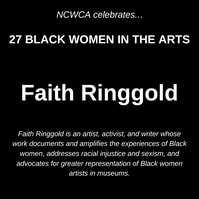
Faith Ringgold is an artist, activist, and writer whose work documents and amplifies the experiences of Black women, addresses racial injustice and sexism, and advocates for greater representation of Black women artists in museums.
*** What can we learn from her life and work? *** 1) Ringgold’s collections of paintings include the “American People Series” that captures the racial tensions and civil unrest of the 1960s as well as the “Black Light Series” influenced by the Black Power movement. In addition, she created “soft sculptures” with her mother, Willi Posey, to bring more dimension to her feminist work highlighting revolutionary Black women. 2) Her renowned story quilts (e.g. “Who’s Afraid of Aunt Jemima”) are inspired by African American quilting traditions and chronicle her experiences as a Black woman living and working in Harlem, NY. These quilts provided an avenue through which Ringgold could share her stories with the public at a time when no one would publish her autobiography. 3) In the 60s and 70s, Ringgold, along with the Ad Hoc Women’s Art Committee, demanded the Whitney Museum of American Art to increase the number of women artists featured at the now Whitney Biennial and to ensure half of these artists are Black women. She co-founded Women Students and Artists for Black Art Liberation (WSABAL) with her daughter, Michele Wallace. 4) As an author, she has written and illustrated notable children’s books, including the award-winning “Tar Beach” as well as “Aunt Harriet’s Underground Railroad in the Sky,” and “If A Bus Could Talk: The Story of Rosa Parks” among others. TAKE TIME: Read more about Faith Ringgold at
** Her retrospective, “Faith Ringgold: American People,” is currently on view at the deYoung Museum of San Francisco from July 16 -November 27, 2022: https://deyoung.famsf.org/exhibitions/Faith-Ringgold-American-People |
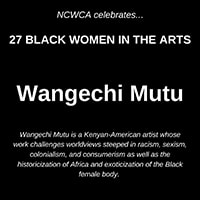
Wangechi Mutu is a Kenyan-American artist whose work challenges worldviews steeped in racism, sexism, colonialism, and consumerism as well as the historicization of Africa and exoticization of the Black female body.
*** What can we learn from her life and work? *** 1) She received a multi-faceted education on three different continents (Africa, Europe, and North America) and is trained in sculpture and anthropology. She received her MFA from the Yale School of Art in 2000. 2) Mutu’s collages, sculptures, paintings, installations, and films juxtapose the beautiful and the grotesque. Often, her work features powerful female figures rendered from human, animal, plant, and mechanical appendages gathered from magazine cutouts, found objects, and painted imagery, all set against mythical landscapes that seem both alluring and threatening. 3) Informed by Afro-futurism and inspired by African history, contemporary politics, folklore, and traditional arts, Mutu creates new mythologies that urge people to question the stereotypes, violence, and preconceptions forced upon women, particularly Black women. Her work expands the possibilities of femininity and deviates from the rigid female tropes present in classical antiquity and pop culture. 4) In 2014, Mutu founded Africa’s Out!, an organization committed to “harness[ing]the power of artists and the creative community, especially from within the African Diaspora, to highlight the urgency of pressing social and political issues through unique and dynamic platforms” (http://africasout.com/aboutus). TAKE TIME: Learn more about Wangechi Mutu at
|
27 Black Women in the Arts:
|
27 BLACK WOMEN IN THE ARTS
|
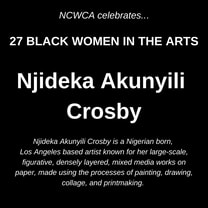
Njideka Akunyili Crosby (nnn-jee-DEH-car ah-KOON-yee-lee) is a Nigerian born, Los Angeles based artist known for her large-scale, figurative, densely layered, mixed media works on paper, made using the processes of painting, drawing, collage, and printmaking.
*** What can we learn from her life and work? *** 1) Akunyili Crosby was a pre-med student before she decided to become an artist. She studied biology and art as an undergraduate at Swarthmore College in Pennsylvania and earned a Post-Baccalaureate certificate at the Pennsylvania Academy of Fine Arts. Following an MFA from Yale University, she was artist-in-residence at Studio Museum in Harlem. Akunyili Crosby has an Honorary Doctorate from Swarthmore College, Swarthmore, PA. 2) A researcher at heart, Akunyili Crosby draws on art historical, personal, sociological and literary references, and depicts scenes of African Diaspora life. Her compositions offer intimate views of everyday, familial experiences, featuring herself, her husband, her immediate and extended family members, thereby collapsing times, spaces, and distances. Akunyili Crosby's work is a contemplation on what it means to be a global, hybridized citizen. Using photographs, magazine cuttings, commemorative fabrics, Nigerian pop and Nollywood references, she deftly navigates liminal spaces and ways of being. 3) Akunyili Crosby is only “the second artist to create an outdoor mural designed specifically to wrap the exterior of MOCA Grand Avenue, LA” (Source: The Museum of Contemporary Art). 4) Akunyili Crosby has received several accolades for her work: a 2017 MacArthur Fellowship, 2016 Financial Times' Women of the Year, the Future Generation Art Prize 2017 Shortlist. She is the recipient of the 2020 Carnegie Corporation “Great Immigrant, Great American” Award; the 2019 African Art Award; the 2016 Prix Canson Prize; the 2015 Foreign Policy's Leading 100 Global Thinkers of 2015 Prize; the 2015 Next Generation Prize, New Museum of Contemporary Art; the 2015 Joyce Alexander Wein Artist Prize, and the 2014 Smithsonian American Art Museum's James Dicke Contemporary Art Prize (Source: Victoria Miro Gallery). TAKE TIME: Read more about Njideka Akunyili Crosby at Njideka Akunyili Crosby Website: http://www.njidekaakunyilicrosby.com/ Victoria Miro Gallery Artists: Njideka Akunyili Crosby: https://www.victoria-miro.com/artists/185-njideka-akunyili-crosby/ W Magazine: "Nigerian Artist Njideka Akunyili Crosby is Painting the Afropolitan Story in America”: https://www.wmagazine.com/story/njideka-akunyili-crosby-artist-painter |
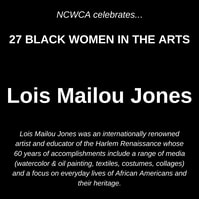
Lois Mailou Jones was an internationally renowned artist and educator of the Harlem Renaissance whose 60 years of accomplishments include a range of media (watercolor & oil painting, textiles, costumes, collages) and a focus on everyday lives of African Americans and their heritage.
*** What can we learn from her life and work? *** 1) Jones was one of the first African Americans to graduate from the Museum of Fine Art in Boston. Later, she became a professor at Howard University in Washington D.C. Her career lasted for 47 years. 2) Her art was influenced by travel. In 1937, she took a sabbatical at the Académie Julian in Paris. There, she received acceptance as a black artist, which was, at the time, absent for people of color in the US. Her travels to Haiti and Africa inspired her interest in her African heritage. She highlighted this in her art by using bold shapes, bright colors and African masks. She loved to combine new and ancient imagery, such as Harlem cityscapes with Egyptian pyramids, as seen in her painting Ascent of the Ethiopian. 3) Lois Mailou Jones was known for depicting the African American experience. She boldly used sensitive subject matter in her work, such as in Mob Victim (Meditation), which is a meditative piece on lynching and the imminent death that many male African Americans faced in the 1940s. In contrast, she also painted more joyful images that celebrated black physical esthetics, showing how beautiful black people were. 4) In America, galleries would not accept Jones’s art because of her color. She never let this bring her down. She would send her artwork to galleries without letting the galleries know that she was a black artist. Her artwork was accepted. She attended the openings anonymously to hear people boast about her art and to see her paintings sell. In addition to promoting her art, Jones was also an advocate for international artists. These artists mostly came from Africa and Haiti and would not have been known to the world without Jones’s tireless philanthropy. TAKE TIME: Read more about Lois Mailou Jones at Lois Mailou Jones on the Smithsonian American Art Museum https://americanart.si.edu/artist/lo%C3%AFs-mailou-jones-5658 Lois Mailou Jones on Wikipedia https://en.wikipedia.org/wiki/Lois_Mailou_Jones Lois Mailou Jones Biography on Web Archive https://web.archive.org/web/20160103225702/http://loismailoujones.com/index.php?page=biography |
27 BLACK WOMEN IN THE ARTS #4
|
27 BLACK WOMEN IN THE ARTS #3 DR SAMELLA LEWIS (1924- PRESENT)
|
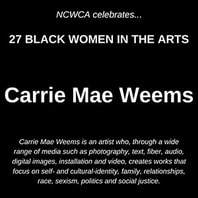
Carrie Mae Weems is an American artist who, through a wide range of media such as photography, text, fiber, audio, digital images, installation and video, creates works that focus on self- and cultural-identity, family, relationships, race, sexism, politics and social justice.
*** What can we learn from her life and work? *** 1) “…Carrie Mae Weems has yearned to insert marginalized peoples into the historical record. She does this not only to bring ignored or erased experiences to light but to provide a more multidimensional picture of humanity as a whole, a picture that ultimately will spur greater awareness and compassion.” Kathryn E. Delmez, Editor, “Carrie Mae Weems: Three Decades of Photography and Video.” Some of her ground-breaking bodies of work include “The Kitchen Table Series “(1990), “From Here I Saw What Happened and I Cried” (1995-1996) and “The Hampton Project” (2000). 2) Weems has exhibited extensively in the US and internationally, in more than 120 venues including the Museum of Modern Art, Getty Museum, Metropolitan Museum of Art, Whitney Museum, the National Museum of Women in the Arts (NMWA), and the Whitney Museum. In 2014, Weems became the first African American woman to have a retrospective at the Guggenheim Museum. Weems was inducted into the International Photography Hall of Fame Museum in St. Louis, MO on October 30, 2020. 3) Weems is a recipient of many prestigious awards and honorary degrees. In 2013, she was awarded the MacArthur Genius Award and the Congressional Black Caucus Foundation’s Lifetime Achievement Award; in 2015, she was awarded both a Ford Foundation Art of Change Fellow and the W.E.B. Du Bois Medal from Harvard. She has received honorary degrees from California College of the Arts, the School of Visual Arts, Syracuse University among others. 4) In 2002, Weems and Pierre Loving co-founded Social Studies 101 in Syracuse, New York. Through this organization, Weems has empowered Black and Latino youth to acquire marketable skills in technological, visual and graphic arts and to affect positive social change in their own community by getting involved in issues such as confronting gun violence and preventing the spread of COVID-19. TAKE TIME: Learn more about Carrie Mae Weems at 1. Fresh Talk: Carrie Mae Weems, National Museum of Women in the Arts, https://www.youtube.com/watch?v=bBxwugaFRhg&list=FLjBSq1m_Qump1ZcTxf0VH7Q&index=3 2. How Carrie Mae Weems Rewrote the Rules of Image-Making, https://www.nytimes.com/2018/10/15/t-magazine/carrie-mae-weems-interview.html 3. Carrie Mae Weems: Three Decades of Photography and Video, Yale University Press, 2012, ISBN: 9780300176896 4. Social Studies 101: http://socialstudiesproject.org/ TAKE ACTION: Continue the legacy of Carrie Mae Weems by supporting Black Women in the Arts: https://news.artnet.com/art-world/where-to-donate-black-lives-matter-1879701 * Special attention to the following organizations: Black Girl Magik, Black Trans Femmes in the Arts, Black Women’s Blueprint, and (Fem)power |
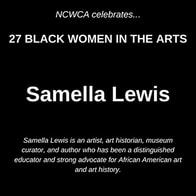
Artist, art historian, museum curator, and author Samella Lewis has been a distinguished educator and strong advocate for African American art and art history.
*** What can we learn from her life and work? *** 1) Dr. Lewis founded L.A.’s Museum of African American Art and served as curator until 1986. She has also helped establish several gallery spaces that exhibit Black artists. 2) As a scholar, she is a trailblazer who has authored numerous important academic books on African American art. In 1969, she co-founded Contemporary Crafts Gallery, the first Black–owned art book publishing house. 3) Dr. Lewis is a renowned artist in her own right and is best known as a printmaker and painter. Often using the human form as her subject, her work addresses the struggles of the African American community. 4) She won the Charles White Lifetime Achievement Award in 1993 and the UNICEF Award for the Visual Arts in 1995. Scripps University established the Samella Lewis Scholarship for African American students. Dr. Lewis also won the Women's Caucus for Art Lifetime Achievement Award in 1989. TAKE TIME: Read more about Dr. Lewis at - https://hammer.ucla.edu/now-dig-this/artists/samella-lewis TAKE ACTION: Continue the legacy of Dr. Samella Lewis by supporting Black Women in the Arts: https://news.artnet.com/art-world/where-to-donate-black-lives-matter-1879701 Special attention to the following organizations: Black Girl Magik, Black Trans Femmes in the Arts, Black Women’s Blueprint, and (Fem)power |
27 BLACK WOMEN IN THE ARTS: #1 AUGUSTA SAVAGE (1892-1962)
|
27 BLACK WOMEN IN THE ARTS #2 ADRIAN PIPER (1948 - PRESENT)
|
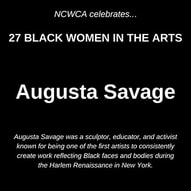
Augusta Savage was a sculptor, educator, and activist known for being one of the first artists to consistently create work reflecting Black faces and bodies during the Harlem Renaissance in New York.
*** What can we learn from her life and work? *** 1) She kindled a relentless, “burning desire” to become a successful sculptor despite her family’s lack of support and difficulty procuring materials in her early years. 2) She sculpted busts of influential Black figures (e.g. W.E.B. Du Bois) and her best-known work, "Gamin," won the Julius Rosenwald Fellowship that enabled her to study in Paris, 1929. Her largest work, "The Harp," was influenced by Black spirituals and hymns. 3) She grew to be a prominent teacher in Harlem after starting the Savage Studio of Arts and Crafts, expressing: “If I can inspire one of these youngsters to develop the talent I know they possess, then my monument will be in their work. No one could ask for more than that.” 4) She trail-blazed, becoming the first 1st director of the Harlem Community Art Center and the first Black member of the National Association of Women Painters and Sculptors. TAKE TIME: Read more about Savage at https://americanart.si.edu/artist/augusta-savage-4269 TAKE ACTION: Continue the legacy of Augusta Savage by supporting Black Women in the Arts: https://news.artnet.com/art-world/where-to-donate-black-lives-matter-1879701 * Special attention to the following organizations: Black Girl Magik, Black Trans Femmes in the Arts, Black Women’s Blueprint, and (Fem)power |
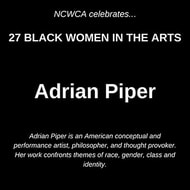
Adrian Piper is an American conceptual and performance artist, philosopher, and thought provoker. Her work confronts themes of race, gender, class and identity.
Learn more about Adrian Piper by visiting her website: http://www.adrianpiper.com/biography.shtml *** What can we learn from her life and work? *** 1) Philosophy influences her conceptual and performance art pieces. So much so that she attained her Ph.D. in philosophy from Harvard University in 1981 and became a tenured philosophy professor at Wellesley College in 1990. 2) Piper’s introduction to performative art in the 1970s explicitly addressed her multiracial background and gender. Her well-known performance of The Mythic Being was filmed during this time where she challenged passers-by to categorize her by race, gender, and class while dressed as an African American man. 3) Before moving to Germany in 2005, Piper founded the Adrian Piper Research Archive (APRA) in Berlin to function as a personal archive as well as an ongoing art project. 4) Well-versed in Kantian ethics, Piper self-published philosophical works of hers like Rationality and the Structure of the Self, Volume I: The Humean Conception and Volume II: A Kantian Conception. These works can be found on her website http://www.adrianpiper.com/index.html 5) Piper received the Women's Caucus for Art Lifetime Achievement Award in 2014. TAKE TIME: Read more about Piper at
TAKE ACTION: Continue the legacy of Adrian Piper by supporting Black Women in the Arts: https://news.artnet.com/art-world/where-to-donate-black-lives-matter-1879701 * Special attention to the following organizations: Black Girl Magik, Black Trans Femmes in the Arts, Black Women’s Blueprint, and (Fem)power |
